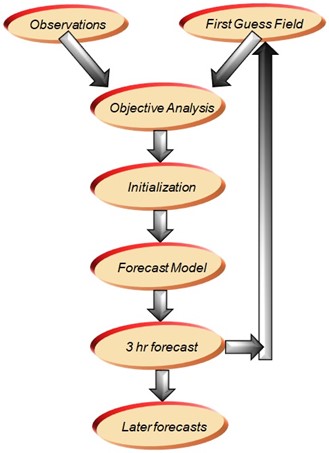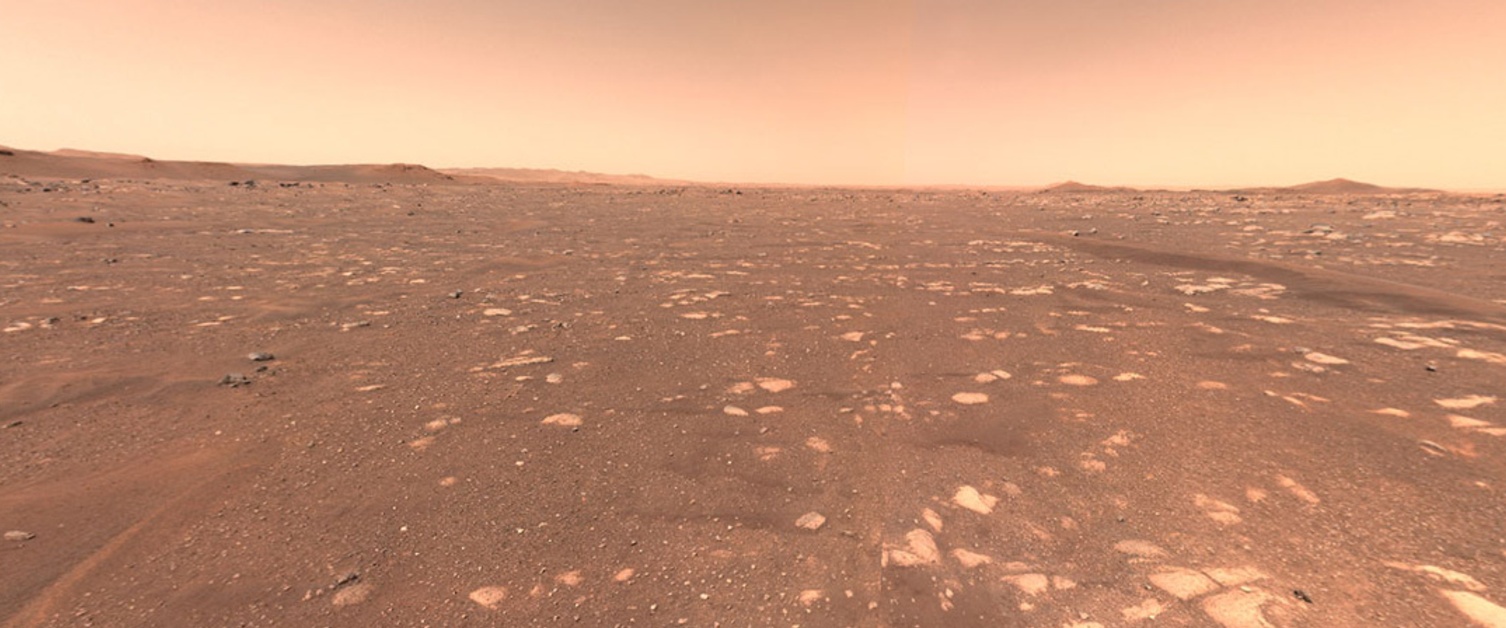Can We Predict Weather on Mars as We Do on Earth?
- By Dr. J. Cory Demko
- May 11, 2021
A portion of the Ingenuity helicopter flight zone on Mars as seen from the Perseverance Rover. Image: NASA-JPL/Caltech
A very thrilling, nervous, and euphoric moment occurred back on February 18th with the touchdown of NASA’s Martian Perseverance Rover. The Perseverance Rover is a component of the larger Mars Exploration Program (MEP) and includes a robotic helicopter named Ingenuity. Perseverance confirmed a successful touchdown within the Jezero crater at 3:55 pm EST, ending a 204-day flight from Earth to its new home, Mars. Meteorological instruments, similar to the Rover Environmental Monitoring Station (REMS) of the Martian rover, Curiosity, have begun recording surface air and ground temperature, wind speed and direction, pressure, relative humidity, and ultraviolet (UV) radiation.
The data recorded by these meteorological instruments are transmitted back to Earth and allow scientists studying Martian meteorology to make firsthand observations of the weather encountered by the Martian rovers. These observations help scientists study not only general circulation patterns and weather systems on Mars such as dust devils, but also provide information on local water cycle habits and the effects UV radiation has upon the surface and subsurface habitability. This is great for studying past and near real-time Martian Weather, but can we predict Martian weather as we do here on Earth?

Figure 1: Credit NASA/JPL-Caltech
To dissect the predictability of Martian Weather, we need to first understand how we predict weather here on Earth. This is done through Numerical Weather Prediction (NWP) models, which are created through a combination of computer models and data from weather observations around the world.
By far, it is weather observations that have the greatest impact and can be the source of the greatest errors within NWP models. To create a forecast, models need to ingest weather observations taken all over the Earth and, using advanced mathematics, properly configure these observations so that we can create an instantaneous “snapshot” of the weather all over the Earth at a singular moment in time. This is like a camera taking a photo but here instead of capturing instantaneous light, our snapshot is created through data from observing numerous atmospheric “state” variables (i.e., temperature, pressure, moisture, wind speed and direction, cloud cover, precipitation) combined with past NWP output. This moment in time, commonly referred to as the model’s initialization period, provides the fundamental basis for prognostic equations (known as the primitive equations within atmospheric science) to begin.
Before getting to the model initialization and prognostic equations, the weather observations have to be processed in specific ways. NWP models require input and output in the form of grids, or grid points. Simply put, these grids (as the name implies) are regularly spaced points upon the Earth surface and throughout the atmosphere. This begs the fundamental question; how do meteorologists take irregularly spaced and timed observations and place them regularly upon a grid over the Earth?
The answer to this question lies in the data assimilation process. Before the prognostic equations begin, and the forecast is created, all meteorological observations and any terrestrial information, such as soil, land use categories, and elevation, must be incorporated into the model. This requires sophisticated mathematics and computational techniques that take the information content of observations and make it usable by the numerical modeling system. That includes interpolating these observations to grid points across the earth. Meteorologists work to minimize errors that creep into the models from this interpolation process, and try to reduce computational numerical errors associated with the data assimilation methods themselves.

Figure 2: Numerical Weather Prediction (NWP) process from ingesting observations and combining them with known physical processes within a technique known as data assimilation.
Data assimilation is not only composed of meteorological observations but is also supplemented with a “first guess” meteorological field. This “first guess” is a short range forecast with state variables at the grid points that is likely being provided from the previous NWP model run. Now one might say that our data should be very accurate given the fact that the Earth has never been observed more in its approximately 4.5-billion-year existence than it is now. Yes, that is correct but remember, the Earth is 71% water with very few observations when compared to land, and land observational platforms in certain parts of the Earth are still very sparse. This “first guess” field helps in areas containing sparse observations.
Observations along with this first guess field combine to create the objective analysis stage. Following objective analysis, initialization brings the initial conditions into dynamical balance. If this balance is not achieved then, due to the first integrations of the primitive equations, the model will generate artificial gravity waves which could potentially amplify through the model’s domain and produce erroneous results. Once the model initializes, the primitive equations are integrated further, and this produces predictions about future atmospheric states (i.e., the forecast). Let’s dive a bit deeper into some of the more crucial data assimilation steps.

Figure 3: Data assimilation process.
As stated above, objective analysis combines observations with a first guess field from a previous model run. Several approaches to objective analysis have been devised over time, and each has their own advantages and disadvantages. The goal is to minimize errors both in the actual observation (i.e., temperature measures from radiosondes have a greater weight - less error - than temperatures derived from satellite measurements) and in the process of interpolating observations to those grid points as referenced above.
The most widely used objective analysis approach in NWP models today is a technique known as variational methods. If both before and after analysis time observations are utilized, then 4-Dimensional variation technique is used (4D-VAR) and if only the analysis time observations are used then the technique is known as 3-Dimensional variation (3D-VAR). The main benefit of using variation methods are that the dynamical constraints mentioned above can be included within this step. This eliminates the need for an additional initialization step and saves computation time.
So, what about data assimilation on Mars?
Earth has a more robust observational network than Mars since, well, we live here. However, a team of researchers in the Department of Physics at the University of Oxford has been dissecting the Mars Data Assimilation problem set. Collaborating with scientists at the Laboratorie de Météorologie Dynamique of the Ecole Normale Supèrieure in Paris and the Université de Paris VI, the Open University, and at the Instituto de Astrofisica de Andalucia in Spain, these researchers are developing a Mars General Circulation Model (MGCM) to produce a Martian Climate Database. This will reveal previously unknown meteorological, climatological, ecological, and chemical properties and phenomena happening on Earth’s closest neighbor and kickstart a plethora of new research. Using MGCM has already allowed these researchers to produce the OpenMARS reanalysis dataset, a Martian global weather record from 1999 to 2015 (approximately 9 Martian years). The database is accessible by all and is a great way to get intimate with Martian weather.
And for looking at Martian weather, data assimilation offers a hidden benefit: a positive, synergistic feedback loop. How, one may ask. Let’s think about this very fundamental question. Through Newtonian physics, data assimilation combines our physical understanding of a system, in this case the Mars-Atmosphere system, with extremely sparse observations producing a global climatological database depicting meteorological observations over previously unobserved locations. This allows researchers a “peek under the hood” at Martian meteorological conditions, targeting future meteorological observations and therefore, positively impacting future data assimilation by reducing error.
Meteorologists working on NWP efforts for Earth-Atmosphere-based models complete similar tasks. This is why I am extremely excited about transitioning this Earth based assimilation techniques to other planetary systems. This positive feedback loop enables scientists and researchers studying Martian meteorological information critical knowledge to support current and future scientific experiments performed by rovers and orbiters as well as future missions.
So, the next time you look up in the sky and locate Mars, you’ll see how hard it is not to stare in awe at how the inhabitants of Earth are creating climatologies and studying the weather on other worlds!
If on Twitter, follow @MarsWxReport to see updates on meteorological conditions from @NASAPersevere @MarsCuriosity and @NASAInSight !
